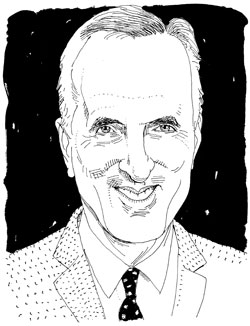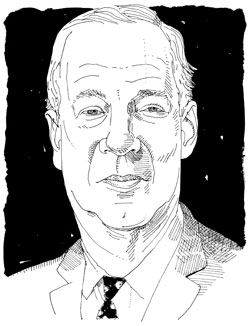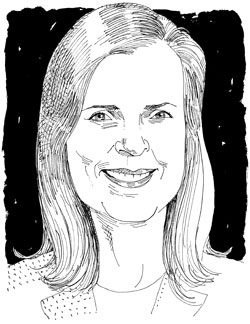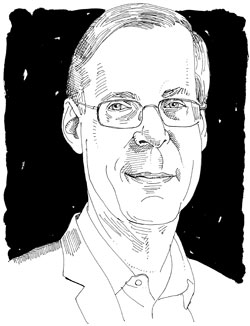FALL 2012 CONTENTS
Home
Bottom line
Medicine's Funding Pool is Drying Up
The competition
On the hunt for research dollars
Against the odds
A band of rebels fights to save health care
Giving well
Philanthropists roll up their sleeves
Melinda Gates on family matters
A conversation about contraception
Testing testing
Why some cancer screenings stir such controversy

DOWNLOAD PRINTABLE
ISSUE (PDF)


Special Report
Giving Well
Philanthropists roll up their sleeves
By Tracie White
Illustrations by Joe Ciardiello
The explosion of wealth in Silicon Valley has brought about a new type of philanthropist, an entrepreneur who not only donates money but draws up a business plan for how that money will be used. This hands-on movement has morphed into a national trend, with more philanthropists not only advocating for their causes but lending their executive expertise as a side benefit.
“It’s a change in public philosophy,” says Leslie Lenkowsky, professor of philanthropic studies and public affairs at Indiana University. "Instead of saying, 'Government should do that,' philanthropists are more than ever stepping in. Instead of letting the U.N. handle malaria, Bill Gates set up his own foundation.
“The epicenter of philanthropic giving in America has shifted from New York to Silicon Valley,” he says. “A lot of people have gotten very wealthy who want to give something back and who want to do it in their active years when they can be involved.”
The roots of what’s been dubbed intentional giving could be said to be as old as U.S. philanthropy itself. Modern-day philanthropy emerged at the end of the 19th century, when an unprecedented number of Americans – including John Rockefeller and Henry Ford – become rich enough to have a role in shaping community and national affairs, says University of Virginia history professor Olivier Zunz, author of Philanthropy in America.
Andrew Carnegie, in his 1889 essay The Gospel of Wealth, gave birth to the idea that the rich should, instead of “leaving their wealth to their families, administer it as a public trust during life.”
“Instead of giving charitable donations to, say, sailors' widows in Salem, giving became something much more broad ‘to the benefit of mankind,‘” Zunz says.
Philanthropists have made enormous social changes in the United States, from Carnegie’s support for science research and higher education to today’s efforts by Bill and Melinda Gates to find solutions to the spread of disease worldwide, says Zunz.
Not surprisingly, many of Stanford University Medical Center’s major financial supporters are deeply involved in solving health care’s challenges, with many contributing not only funds but years of hands-on volunteer work. Read on for some of their stories about how and why they give.

Ask JOHN LEVIN, who has donated millions to Stanford University and volunteered his time in numerous capacities for more than 30 years, where his passion for public service comes from, and he pauses. Levin, 64, the co-founder and chairman of the San Francisco law firm Folger Levin, who seems rarely lost for words, spends a few extra moments searching for just the right ones.
“I suppose it goes back to my childhood,” he says quietly.
“My mother contracted polio when I was an infant. She was in an iron lung in the hospital for years. When I would visit her I just remember her head poking out from the iron lung. She always had a smile on her face. That’s all I could see of her. I was a kid. I didn’t understand the terror that she was going through trapped in an iron lung for years.”
Levin goes on to tell the story of his mother’s dedication to public service despite seemingly overwhelming obstacles. How she left the hospital a quadriplegic attached to a portable respirator. How she started reading to blind college students in their Los Angeles home and how that motivated her to return to college, eventually becoming a staff therapist at a suicide prevention center answering hotline calls from home. She realized that even as a quadriplegic she could find meaning in life by being involved and useful in helping others.
“I’ve no doubt my mother’s story had a great influence over my life,” he says.
Levin and his wife, Terry, are both Stanford alumni and longtime Stanford volunteers. (The couple’s twin 25-year-old daughters are Stanford alumni too.) John has served on the university's and Stanford Hospital’s board of trustees for decades. He’s been active in fundraising at the law school and as a mentor to law students. Together he and his wife donated $3.75 million to establish the John and Terry Levin Center for Public Service and Public Interest Law at the law school in 2007 – the center’s mission is to make public service a pervasive part of every law student’s experience.
‘It’s obviously a very scary, very frightening thing. My wife’s cancer clearly was a motivating factor for both of us.’
“The whole notion of law as a profession is the fact that it’s primarily about service to others,” says Levin, who received his law degree from Stanford in 1973.
The Levin family’s most recent donation of $10 million to help build the new Stanford Hospital and John’s participation in the hospital’s fundraising campaign perhaps most clearly reflect the influence of his mother as a role model, her struggle with polio and her passion for public service.
“Back to my infancy, I understood the impact and power of medicine to make a difference in people’s lives,” Levin says. “It’s a universally important subject. There are a few issues that are of paramount importance to the country and the world, chief among them education and medicine. I believe philanthropy and engagement should be coupled. The more you get involved, the more effective you can be in making a difference.”

Nearly a dozen years ago, JOHN FREIDENRICH, a longtime supporter of the university and the medical center, attended one of the yearly retreats held by the medical school’s dean, Philip Pizzo, MD, in the Monterey area. That year, the retreat focused on the topic of “translational medicine” – the efforts to put research from the science lab to use in clinical care.
“I offered to give the dean a ride home,” says Freidenrich, 75, a lawyer turned venture capitalist and investor, and an alumnus of both Stanford University and the law school. “Along the way, I told him, ‘Phil, that was a great program, but if you don’t do something about it, it’s just going to go up into thin air. By next year no one will remember it.’
“Don’t ever ride in a car with Phil,” he jokes. “It was a very expensive ride.”
John and his wife, Jill, who met as Stanford undergrads, live in Atherton, Calif., and have been married for 49 years. They have two children and six grandchildren. John's early work as a lawyer led to the founding of Ware and Freidenrich, catering to the business, legal and financing needs of start-up companies. The firm, now part of the global law giant DLA Piper, and John's later career in venture capital and investment management, paralleled the rise of Silicon Valley.
The Freidenriches have been committed donors to the university for decades. John has chaired the university’s board of trustees and countless committees. The couple’s support of the arts at Stanford is reflected in the Freidenrich Family Gallery at the Cantor Art Center. Jill, a breast cancer survivor, founded Breast Cancer Connections, a Palo Alto support network for people with breast cancer. They’ve funded Stanford scholarships and in 2009 created the Freidenrich Support Foundation, organized exclusively for charitable, scientific and educational purposes at Stanford.
But there was more to come.
“Several years later, Phil came back to me after that car ride and said that the School of Medicine had been working on this idea and wanted to create a program for translational medicine, including a building dedicated to this research.”
The building and program would become the Jill and John Freidenrich Center for Translational Research at Stanford University, designed to be the hub for the school’s work in translational medicine. It officially opens this fall.
The Freidenriches donated $25 million to the School of Medicine to boost its work in translational research in cancer and other diseases.
“It’s one thing to do research. But if you really want to help people who are ill, you want to develop the best therapies and then conduct clinical trials. We have to find more ways to go from the bench to clinical trials to patients.”
But one of the strongest motivating factors for this donation was Jill’s battle with breast cancer. “It’s obviously a very scary, very frightening thing,” he says. “My wife’s cancer clearly was a motivating factor for both of us. Stanford has world-class researchers and clinicians, so I don’t think there’s any place better suited to carry out this work.”

DENISE O'LEARY has given both time and money to Stanford University for so long it has become a way of life. A Stanford graduate, who met her husband, also a Stanford alum, while they were both getting their MBAs at Harvard University, her history of giving began when she returned to Silicon Valley.
“I came back to the West Coast and started working in the venture capital world,” O’Leary says. “I wanted to see if I could get involved doing some volunteer work at Stanford, something more issue-related than just working on my reunions.”
While working, first as an associate, then a general partner, for Menlo Ventures, O’Leary started her first volunteer stint at the university as a member of the Subcommittee on Investment Responsibility during the 1980s, when university investments in South Africa during the anti-apartheid movement sparked campus protests and political debate. From there, she became an alumni-elected member of the board of trustees and was assigned to its medical center committee. A few years later, she became an active hospital volunteer and never really quit.
O’Leary now has 31 years’ combined service on the boards of both Stanford Hospital & Clinics and Lucile Packard Children’s Hospital.
“In my venture world, I did a lot of health-care investing so naturally I was interested in both hospitals. That, combined with my work on the board of trustees, led me to join both hospital boards.” About 15 years ago, she quit full-time work in venture capital to spend more time with her children, a son and a daughter, but continued volunteering at Stanford.
‘You don’t do 31 years of volunteer work unless you really love it. It’s become like a third child.’
“I really fell in love with Stanford Medicine,” O’Leary says. “What our faculty do there is so transformative. You don't do 31 years of volunteer work unless you really love it. It’s become like a third child.”
During her years on the hospital boards helping with fundraising efforts, she’s become something of an expert on medical philanthropy – donors’ motivations and the trends in philanthropic giving. She also has firsthand experience as a medical philanthropist herself. Her family has endowed a professorship at the university, given to Stanford athletics and other funds on campus, and pledged $1 million to the Stanford Hospital Campaign. Her husband, Kent Thiry, is chief executive officer of DaVita Inc., a kidney dialysis company, which moved its headquarters from California to Denver in 2009. O’Leary has continued her work at Stanford from Colorado, traveling west many times a year.
Medical philanthropists, she says, tend to be passionate givers. They are often moved to give to say “thank you” for medical care that saved their own lives or the lives of loved ones. Others give because they’ve lost loved ones due to a lack of medical advances.
“Some donors have been touched by a medical crisis and there was no answer,” O‘Leary says. “They get very passionate with donating to research.”
Over the years, she has also seen a growing desire among donors for accountability as to how their donations are used. Along with this has come more hands-on giving, with donors volunteering their time and their skills.
“The days of writing a $10 million check and not really caring exactly how it’s used are pretty much gone,” she says. “Given our role in Silicon Valley, there’s this excitement around the whole ‘venture philanthropy’ movement. People talk a lot more about ‘intentional philanthropy.’ Donors are more involved.”
Venture philanthropy applies the concepts of venture capital finance to achieve philanthropic goals – focusing on getting measurable results; on giving financial, intellectual and human capital; and on a willingness to try new approaches.
All of these trends are welcomed at Stanford, situated in the midst of Silicon Valley, says O’Leary. The medical center is a natural draw for medical philanthropists in the valley, searching for a meaningful way to give, she says. “The power of a place like Stanford is our ‘bench to bedside’ ability,” she says, referring to the ability to transfer success in the laboratory into improved care at the hospital. “And health care is an enormous motivator. All other things in life pale in comparison to health.”

For CHRISTOPHER REDLICH, a 1972 Stanford graduate, giving to the Medical Center began with a concerted effort to choose an area that both interested him and could help change the world. Five years ago, as he approached his retirement years, he began planning for a meaningful way to give. He’d made his fortune as chair of Marine Terminals Corp., which has interests in ports, marine terminals, stevedoring, warehousing, industrial maintenance, leasing, insurance underwriting and software development. Certainly nothing to do with medicine.
But medicine had made his list of philanthropic interests, along with education, the environment and government reform.
“I retired in 2007 and was talking to people. I was doing my own research, looking around, ” he says. He chatted informally with Mariann Byerwalter, chair of Stanford Hospital's board and a friend of his wife’s who lived in their Hillsborough, Calif., neighborhood.
“It was sort of a curious thing,” he says. “We would meet as I was taking my walk and she was coming up from golf, and we’d stop and talk about it for a while and then she’d go on her way and I'd go on my way. And then finally one time she said, ‘Now Chris, are you really interested in this thing?’”
Redlich, 62, began volunteering as a member of the board, a position where he could learn about Stanford Hospital and the people involved with it. “I was very impressed with the professionalism and collegiality of the board and was given the honor to join as a full board member shortly thereafter.” Eventually he saw that Stanford’s medical center could become a major change agent, and he decided to donate $50 million to help launch the center’s current fundraising campaign and the construction of Stanford's new hospital.
“I see the hospital as the first step in a long chain of steps that need to take place that will hopefully make a significant contribution to the health of this country, both from a medical and fiscal standpoint,” he says.
“Hospital facilities are part of the attraction to top talent,” he says. “By putting this hospital in this location, in this university, we will be able to attract the best people, we’ll be able to provide the best medical services, and we’ll be able to adjust and adapt as medicine changes throughout time. We’ll be able to provide an example to the world.”
But the choice to give to the hospital was not purely intellectual. Personal experience was also a strong motivation. Redlich watched as a number of his relatives died in hospitals, and he began to note the mistakes made in their care along the way. His own visit to an emergency room for an infected toe helped him spot what he describes as the inherent weaknesses in the medical system.
“Good customer experience creates better business opportunities,” says Redlich. “What you don’t do is waste huge amounts of people’s time, make them wait for weeks for appointments, send them from specialist to specialist, leave them waiting for hours in the waiting room.”
What you do, he says, is get involved and help fix the problems.
“The question becomes, how do you make things better?”
Stanford Medical Center’s Campaign
The Campaign for Stanford Medicine, a $1 billion initiative to advance research and teaching at the Stanford University School of Medicine and enable the building of the new Stanford Hospital, has reached more than $600 million in commitments through Aug. 31, 2012. Stanford University President John Hennessy announced the campaign in May.
Among the recent pledges to the campaign are $10 million commitments to the new hospital from Jill and John Freidenrich, Terry and John Levin, and a third anonymous donor. The Younger Family has pledged an additional $5 million to Stanford Hospital & Clinics and the Stanford School of Medicine, adding to a previous pledge of $5 million.

